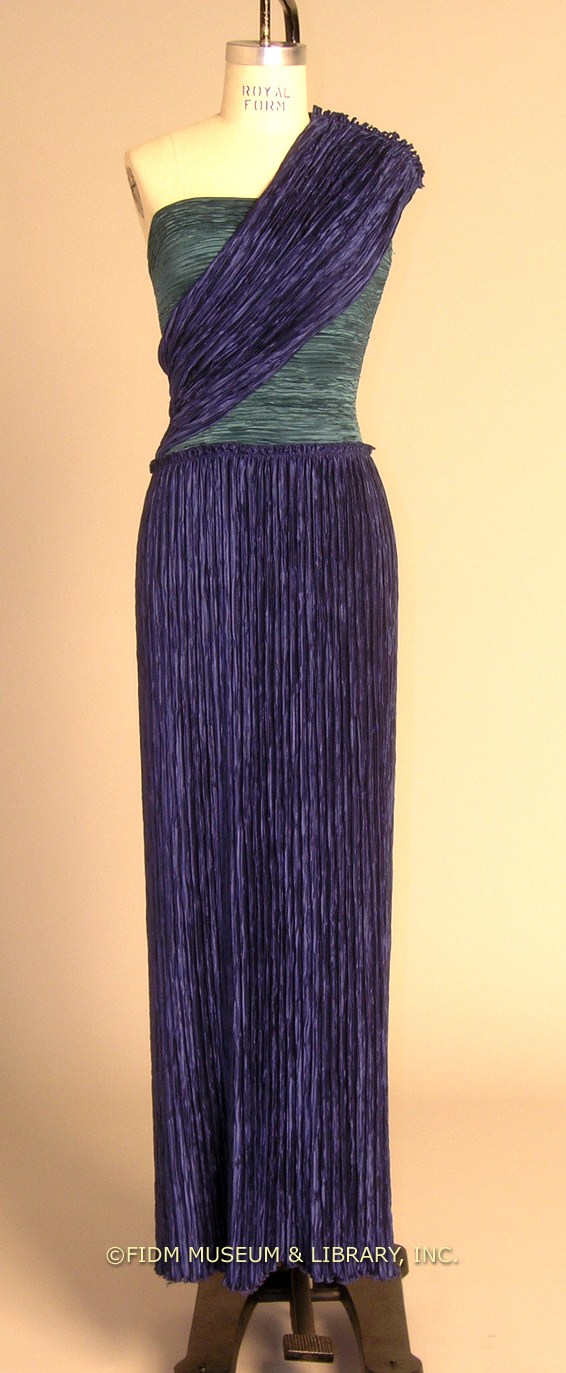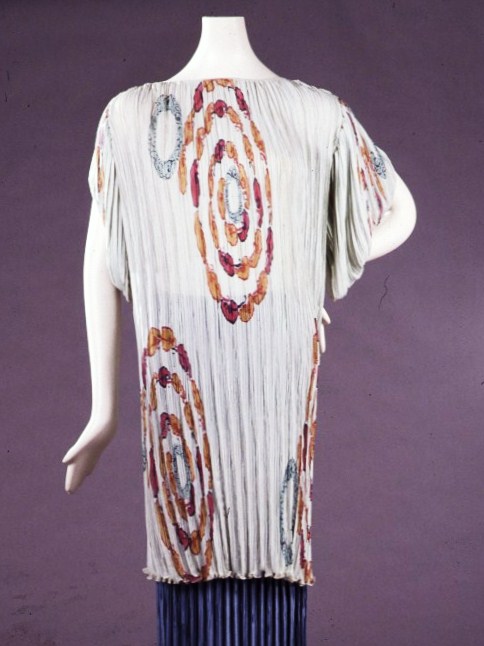If you read our recent post on Mariano Fortuny, this dress may look somewhat familiar. Slim, columnar and featuring narrow pleats, this Mary McFadden (b. 1938) dress is reminiscent of Fortuny's iconic Delphos dress. Though both share an obvious interest in the dress of ancient Greece, unlike Fortuny's unstructured silk gowns, this McFadden evening dress uses boning to shape the bodice.
 Mary McFadden
Mary McFadden
1984-86
2002.149.36
Gift of Patricia G. Waldron, M.D.
Like Fortuny, McFadden designed with a relative unconcern for fashion trends. Instead, she used her designs as a way to explore her personal interests: visual art and the decorative traditions of historic and non-Western cultures. McFadden's current preoccupation was usually revealed by the name of the collection. In 1983, McFadden presented a collection based on the Italian Renaissance, while in 1988 she based her collection on The Tale of Genji, an 11th century Japanese novel portraying the life of a nobleman. A 1995 collection was called the Cult of Osiris, referencing the Egyptian god of the afterlife. Despite their diverse influences, each of these collections highlighted pleated fabric. Often, McFadden paired a simple, pleated skirt with a more elaborate bodice that showcased the specific influences of the relevant collection.

Mary McFadden
c. 1989
Gift of Shirley Wilson
97.c1989.70.14AB
Unlike Fortuny, who is remembered for his nearly permanent pleating of silk, McFadden uses synthetic fiber to achieve a permanent pleat in her designs. When McFadden first began designing in about 1975, she used pleated silk, which was then hand-painted or otherwise embellished. McFadden was dissatisfied with the tendency of the silk pleats to come undone, so quickly she switched to a synthetic pleated textile. Called 'Marii,' this synthetic charmeuse was woven in Australia , dyed in Japan and pleated in the United States. To protect the specific process, McFadden trademarked Marii. Though slightly stiffer, shinier and less drapable than Fortuny's pleated silk, McFadden goal is to create an effect similar to that of Fortuny's gowns. In her words, "the effect I'm searching for is to have the fabric fall like liquid gold against the body."1
How conscious is McFadden's appropriation of Fortuny's trademark pleats? Both McFadden herself and fashion critics have noted the similarity of the pleats used by McFadden and Fortuny. In 1981, McFadden attended the opening of a Fortuny exhibit at FIT in New York. Interviewed at the opening, she is reported to have said about the rainbow array of Fortuny gowns on display, "I've never seen these before. It's staggering."2 Though she may have been aware of Fortuny's work, this comment would suggest that it was McFadden's interest in exploring the history and artistic traditions of other cultures that led her to create pleats, not a specific interest in replicating Fortuny's work.
1 McFadden, Mary and Ruta Saliklis. Mary McFadden: High Priestess of High Fashion. Charleston, MA: Bunker Hill Pub. in association with Allentown Art Museum, 2004. 9.
2 Schiro, Anne-Marie. "A Fashion Institute Exhibition for Fortuny." New York Times. 15 Apr. 1981: C22.

